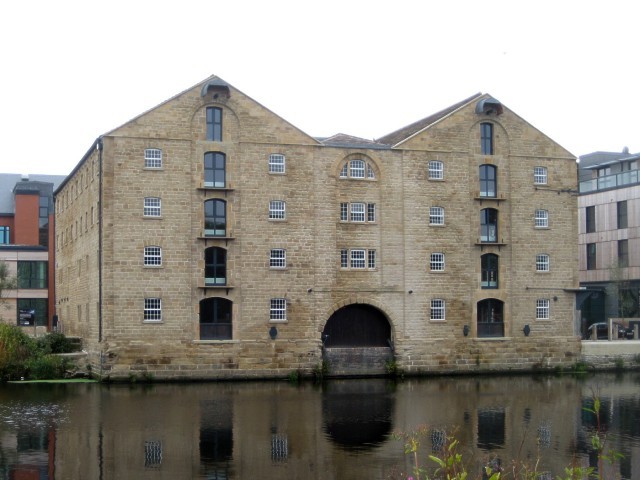The Heavy Woollen District is the name given to the area centred around Dewsbury, Batley, Morley and Ossett and the surrounding towns in West Yorkshire, whose prosperity in the mid-19th century was built on the manufacture of shoddy and mungoManufacture of shoddy and mungo, an early form of recycling, was an important industry in the Heavy Woollen district of West Yorkshire., an early form of recycling. Reclaimed fibres were mixed with wool to produce heavy woollen goods such as blankets, cloth for overcoats, uniforms and horse rugs.
Transport was an important factor in the area’s development, and trade was stimulated after the opening of the Calder and Hebble Navigation
Constructed between 1758 and 1834, the navigation makes the River Calder navigable between Sowerby Bridge and Wakefield in the West Riding of Yorkshire. in 1760 and access to the growing canal network. By the start of the Victorian age, Dewsbury was a flourishing woollen manufacturing town and Batley was “the heart of the shoddy trade”.[1] When the railway arrived in the towns in 1848, the area became known as the Heavy Woollen District and the centre of the reclaimed wool sector.[1]
Background
The area around Batley and Dewsbury became known for woollen manufacture, which started as a domestic industry and for centuries was carried on in the homes of the workers.[2] A considerable number of clothiers produced cloth pieces that were taken to the cloth halls in Huddersfield, HalifaxRare example of a large-scale cloth hall – an exchange for trading woollen and worsted cloth "pieces" – that is largely intact. and LeedsSix cloth halls have been built in Leeds since 1711, and the remains of two survive. Four were for white cloth, one for mixed or coloured cloth and one for cloth made by unapprenticed clothiers. .[3]
As mechanisation developed at the beginning of the 19th century, machines for carding and spinning were developed, and fulling stocks used water power and the first mills were built. Blankets and heavy woollen cloth for overcoats and capes for travellers and horse rugs were the principal items manufactured in the area.[4] Unpatented rag machines were in use in London in the early 1800s producing flock to stuff upholstery and in saddle making, and for grinding cotton and linen to make paper.[2][5]
Shoddy and mungo
Shoddy, fibre made from recycled wool, was first made in Batley in 1813 by Benjamin Law at Howley Mill, who had seen flock manufactured from old stockings, hosiery and old blankets in London. The process involved grinding soft woven woollen rags into a fibres which could be mixed with fresh wool and be re-spun into yarn.[5] Mungo was first produced in 1834 by Law’s business partner, Benjamin Parr. It is ground from hard rags, closely woven fabric and dress-coats, tailors’ cuttings. Both kinds of rags, once nearly valueless, are shredded by a machine, known as the devil, which has a cylinder set with sharp iron teeth that revolves at high speed. The rags are converted into a fibre that can be mixed with sheep’s wool or turned into flock.[5] Waste and dust from the process was collected and used as soil conditioner in the nearby Rhubarb TriangleForced rhubarb growing area in West Yorkshire, England between Wakefield, Morley and Rothwell..[6] Rag merchants who supplied the manufacturers were an important part of the industry employing sorters and packers.[7]
The object of using shoddy in woollen manufacture was to produce cheap, useful cloth in the most economical way. When not added in too great a proportion, shoddy cloth was cheaper than pure wool but equally serviceable. Adding too much shoddy produced cheap but inferior cloth and shoddy came to mean poor quality.[8]
Extent
After 1813 when the shoddy industry started in Batley, the population was about 3,000 and woollen manufacture was on a small scale.[9] By 1860 the population had more than trebled and Batley was a thriving town with many mills situated in the valley.[10] By 1860 there were 35 mills, large and small.[11]
Dewsbury, likewise more than trebled its population from 4,566 to more than 14,400 in 1851.[12] There were 23 mills producing shoddy and mungo, fifteen for shoddy cloth, two exclusively producing raw mungo or shoddy and six producing yarn or carpets.[13] Dewsbury manufacturers started to build warehouses close to the railway, where their goods could be sold.[14]
Mills in Mirfield were mostly producing worsteds until a cluster of mills was built on the banks of the River Calder.[15] In Ossett, mills mostly produced mungo and forty rag machines were in operation. Millowners in Ossett also worked several mills at PotovensHamlet on the Wakefield Outwood, now known as Wrenthorpe, where small pot works were built. and Horbury.[16] Morley was important in manufacturing shoddy cloth, particularly union cloth.[17] Morley had fourteen mills engaged in the trade, both spinning using mules and power looms.[18] A dozen rag machines produced mungo.[19]
Earlsheaton’s “blanket mills” produced white and coloured blankets using yarn spun elsewhere in the district. Other villages around Dewsbury – Hanging Heaton, Chickenley, Chidswell and Shaw Cross – were all engaged in woollen manufacture.[20] Heckmondwike had built a Blanket Hall, a market for the sale of blankets in the early 1800s; it was still the principal article made there in 1860.[21] Elland, which once had a cloth hall, and neighbouring Stainland, also manufactured a variety of woollen goods,[22] at seventeen mills in Elland, seven in Stainland and four in Greetland.[23]
In May 1864 the Dewsbury Chamber of Commerce proposed forming a Chamber of Commerce for the entire Heavy Woollen District, to include Dewsbury, Batley, Mirfield, Heckmondwike and Ossett, which would have more influence than separate chambers.[24]


